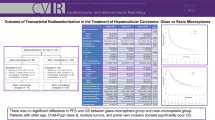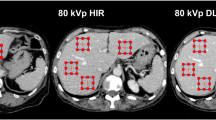Abstract
Purpose
Factors affecting tumor-to-normal tissue ratio (T:N) have implications for patient selection, dosimetry, and outcomes when considering radioembolization for HCC. This study sought to evaluate patient, disease specific, and technical parameters that predict T:N as measured on planning pre-90Y radioembolization 99mTc-MAA scintigraphy for hepatocellular carcinoma (HCC).
Methods
99mTc-MAA hepatic angiography procedures with SPECT/CT over a 4-year period were reviewed. Data recorded included patient demographics, details of underlying liver disease, tumor size, history of prior treatments for HCC and technical parameters from angiography. Anatomic-based segmentation was performed in 93 cases for measurement of tumor and perfused liver volumes and SPECT counts. T:N were calculated and correlated with collected variables.
Results
Mean calculated T:N was 2.52. History of prior ablation was significantly correlated with higher T:N (mean 3.39 vs 2.24, p = 0.003). Cases in which mapping was being performed for treatment of disease progression was significantly correlated with higher T:N (mean 3.35 vs 2.14, p = 0.001). Larger tumor size trended toward lower T:N (p = 0.052).
Conclusion
Patients with history of ablation and those undergoing treatment for disease progression have higher T:N and, therefore, could be considered for radioembolization preferentially over alternative treatments.

Similar content being viewed by others
References
Salem R, Johnson GE, Kem E, et al. Yttrium-90 radioembolization for the treatment of solitary, unresectable HCC: The LEGACY study. Hepatol. 2021; 74(5): 2342-52
Garin E, Lenoir L, Rolland Y, et al. Dosimetry based on 99mTc-Macroaggregated albumin SPECT/CT accurately predicts tumor response and survival in hepatocellular carcinoma patients treated with 90Y-loaded glass microspheres: preliminary results. J Nucl Med. 2012; 53:255–263
Salem R, Johnson GE, Riaz A, et al. Yttrium-90 glass microspheres in the treatment of early and advanced hepatocellular carcinoma: the LEGACY study. Ann Oncol. 2020; 31(S4):S692-S693
Vouche M, Habib A, Ward TJ, et al. Unresectable solitary hepatocellular carcinoma not amenable to radiofrequency ablation: multicenter radiology-pathology correlation and survival of radiation segmentectomy. Hepatology. 2014; 60(1):192-201
Lewandowski RJ, Gabr A, Abouchaleh N, et al. Radiation segmentectomy: potential curative therapy for early hepatocellular carcinoma. Radiology. 2018; 287(3):1050-1058
Chan KT, Alessio AM, Johnson GE, et al. Hepatotoxic dose thresholds by positron-emission tomography after Yttrium-90 radioembolization of liver tumors: a prospective single-arm observational study. CardioVasc Interv Radiol. 2018; 41:1363-1372
Salem R, Thurston KG. Radioembolization with 90Yttrium microspheres: a state-of-the-art brachytherapy treatment for primary and secondary liver malignancies: technical and methodologic considerations. J Vasc Interv Radiol. 2006; 17:1251-1278
Lau WY, Lai ECH, Leung TWT. Current role of selective internal irradiation with Yttrium-90 microspheres in the management of hepatocellular carcinoma: a systematic review. Int J Radiat Oncol Biol Phys. 2011; 81(2):460-467
Kao YS, Tan EH, Ng CE, Goh SW. Clinical implications of the body surface area method versus partition model dosimetry for yttrium-90 radioembolization using resin microspheres: a technical review. Ann Nucl Med. 2011; 25:455-461
Tong AK, Kao YH, Too CW, et al. Yttrium-90 hepatic radioembolization: clinical review and current techniques in interventional radiology and personalized dosimetry. Br J Radiol. 2016; 89:20150943
Kao YH, Tan EH, Burgmans MC, et al. Image-guided personalized predictive dosimetry by artery-specific SPECT/CT partition modeling for safe and effective 90Y radioembolization. J Nucl Med. 2012; 53:559-566
Garin E, Lenoir L, Edeline J, et al. Boosted selective internal radiation therapy with 90Y-loaded glass microspheres (B-SIRT) for hepatocellular carcinoma patients: a new personalized promising concept. Eur J Nucl Med Mol Imaging. 2013; 40:1057-1068
Garin E, Tzelikas L, Guiu B, et al. Personalised versus standard dosimetry approach of selective internal radiation therapy in patients with locally advanced hepatocellular carcinoma (DOSISPHERE-01): a randomised, multicentre, open-label phase 2 trial. Lancet Gastroenterol Hepatol. 2021; 6(1):17-29
Ashfaq A, Gates V, Salem R, et al. Hepatic tumor to normal tissue activity ratio comparison of two primary disease cohorts: hepatocellular carcinoma (HCC) vs neuroendocrine disease (ND) with metastatic hepatic tumor. J Nucl Med. 2010; 51(s2):2132
Goldin D, Campbell J, Emerson S, et al. Tumor-to-normal particle deposition ratio in primary versus secondary liver malignancies: impact on tumor dose and radioembolization treatment planning. J Vasc Interv Radiol. 2014; 25(s3):S89-90
Van Beers BE, Leconte I, Materne R, et al. Hepatic perfusion parameters in chronic liver disease: Dynamic CT measurements correlated with disease severity. Am J Roentgenol. 2001; 176:667-673
Deipolyi AR, Zhu AX, Oklu R. Intratumoral vascular shunting: biomarker of clinical outcome and source of circulating tumor cells? Am J Clin Oncol. 2015; 38:621-626
Garin E, Palard X, Rolland Y. Personalised dosimetry in radioembolization for HCC: impact on clinical outcome and on trial design. Cancers. 2020; 12(6):1557-1575
Wu XZ, Xie GR, Chen D. Hypoxia and hepatocellular carcinoma: The therapeutic target for hepatocellular carcinoma. J Gastroenterol Hepatol. 2007; 22:1178-1182
Lai JP, Conlet A, Knudsen BS, et al. Hypoxia after transarterial chemoembolization may trigger a progenitor cell phenotype in hepatocellular carcinoma. Histopathology. 2015; 67:442-450
Chen C, Lou T. Hypoxia inducible factors in hepatocellular carcinoma. Oncotarget. 2017; 8(28): 46691-46703
Bastiaannet R, Kappadath SC, Kunnen B, et al. The physics of radioembolization. EJNMMI Physics. 2018; 5:22-49
Wondergem M, Smits MI, Elschot M, et al. 99mTc-macroaggregated albumin poorly predicts the intrahepatic distribution of 90Y resin microspheres in hepatic radioembolization. J Nucl Med. 2013; 54:1294-1301
Gnesin S, Canetti L, Adib S, et al. Partition model-based 99mTc-MAA SPECT/CT predictive dosimetry compared with 90Y TOF PET/CDT posttreatment dosimetry in radioembolization of hepatocellular carcinoma: a quantitative agreement comparison. J Nucl Med. 2016; 57:1672-1678
Richetta E, Pasquino M, Poli M, et al. PET-CT post therapy dosimetry in radioembolization with resin (90)Y microspheres: comparison with pre-treatment SPECT-CT (99m)Tc-MAA results. Phys Med. 2019; 64:16-23
Garin E, Rolland Y, Edeline J, et al. Personalized dosimetry with intensification using 90Y-loaded glass microsphere radioembolization induces prolonged overall survival in hepatocellular carcinoma patients with portal vein thrombosis. J Nucl Med. 2015; 56: 339–346
Acknowledgements
The authors would like to acknowledge Mirada Medical (Denver, CO) for providing access to and support for their Simplicit90Y image fusion and dosimetry planning software.
Funding
Mikin V Patel has received consulting fees and speaker honoraria from Boston Scientific. This study was self-funded. No external funding sources were used.
Author information
Authors and Affiliations
Corresponding author
Ethics declarations
Ethical approval
Local Institution Review Board determined that formal consent was not required for this type of study.
Additional information
Publisher's Note
Springer Nature remains neutral with regard to jurisdictional claims in published maps and institutional affiliations.
Rights and permissions
Springer Nature or its licensor (e.g. a society or other partner) holds exclusive rights to this article under a publishing agreement with the author(s) or other rightsholder(s); author self-archiving of the accepted manuscript version of this article is solely governed by the terms of such publishing agreement and applicable law.
About this article
Cite this article
Patel, M.V., McNiel, D., Brunson, C. et al. Prior ablation and progression of disease correlate with higher tumor-to-normal liver 99mTc-MAA uptake ratio in hepatocellular carcinoma. Abdom Radiol 48, 752–757 (2023). https://doi.org/10.1007/s00261-022-03718-8
Received:
Revised:
Accepted:
Published:
Issue Date:
DOI: https://doi.org/10.1007/s00261-022-03718-8




